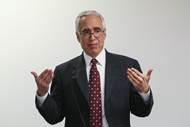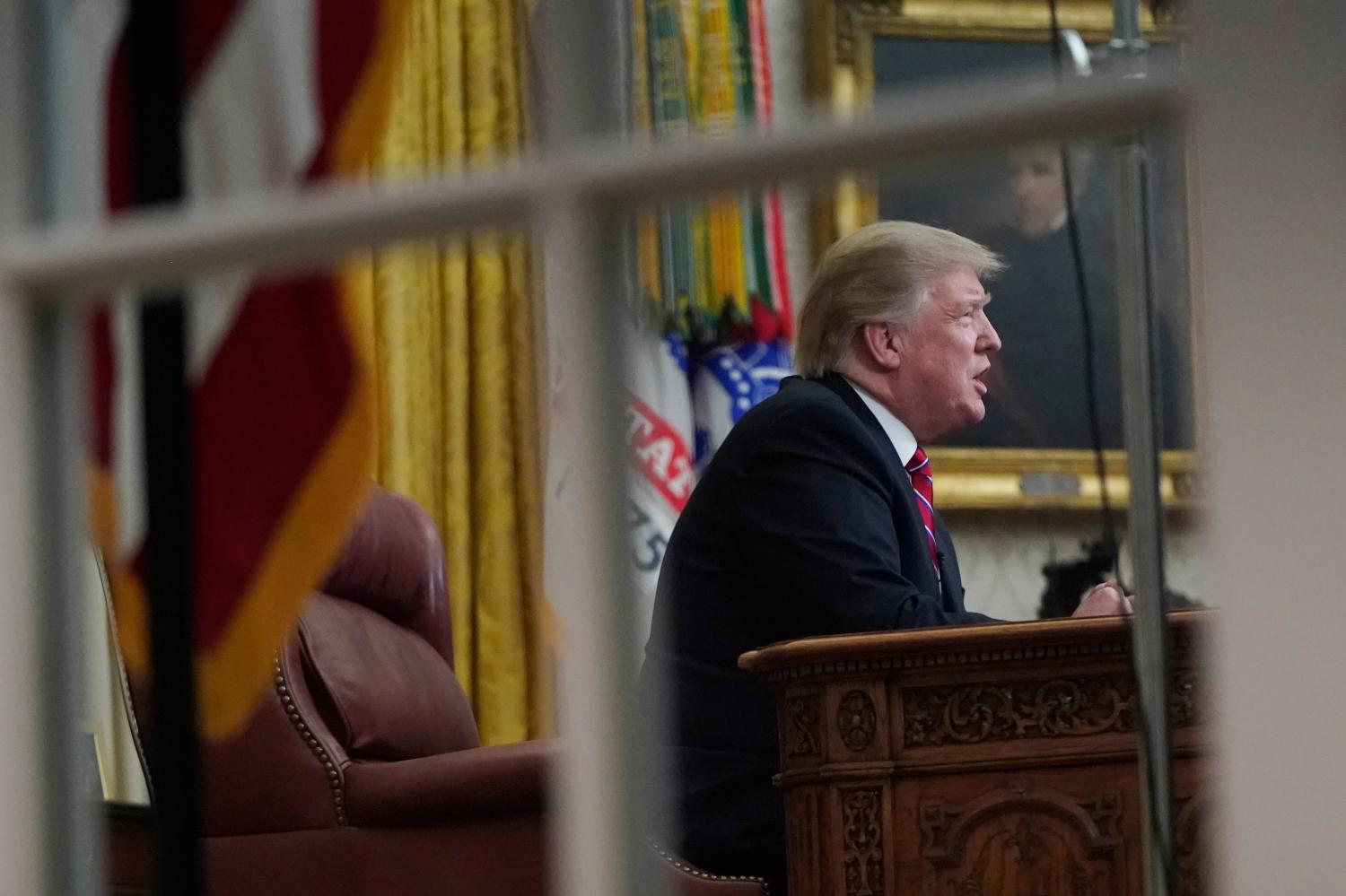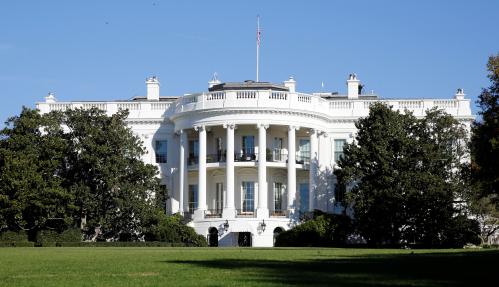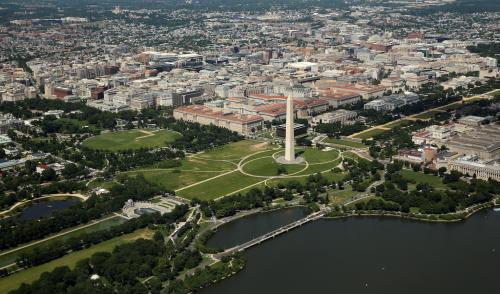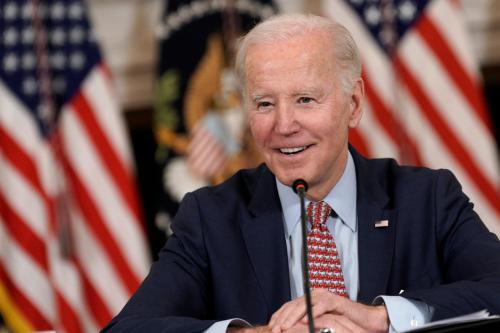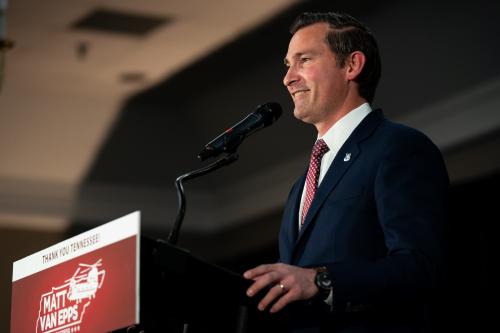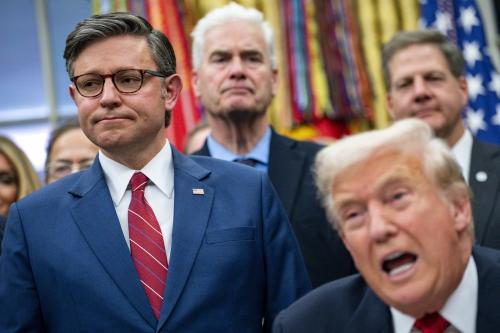Donald Trump won the electoral vote in 2016 as the candidate of Americans who wanted “very major” government reform and a smaller government that delivers fewer services.1 The number of dismantlers, as I call this group, surged from a 17% share of public support in 1997 to a 43% plurality in August 2016 before falling back nine percentage points to 35% in October 2018.2
In the meantime, Hillary Clinton won the popular vote as the candidate of Americans who favored a combination of very major government reform and a bigger government that delivers more services. The number of rebuilders, as I call this group, surged from a 16% share of public support in 1997 to a 25% share in August 2016 before accelerating 11 percentage points to 36% in October 2018, creating a statistical dead heat with the dismantlers.
This realignment of public views toward government reform sets the stage for a showdown between two very different destinations for reform in the 2020 presidential campaign. There will be other issues on the campaign agenda in two years, including Trump’s conduct, but this report will argue that government reform could well decide the winner. Untethered to a sitting administration, the next Democratic presidential nominee will be free to introduce government reform as part of a full-blown attack on Trump, his appointees, and his funders, even as she or he offers Americans a reason for hope as the nation rebuilds a broken federal bureaucracy.
The report will begin the 2020 discussion with an introduction to the four types of government reform (dismantlers, rebuilders, streamliners, and expanders), a review of increased demand for “very major” government reform, and a discussion of the demographic, partisan, and ideological differences between the four reform groups. The report will then turn to the shared distrust toward government among the dismantlers and rebuilders, the electoral dilemma that will dog Trump in 2020, and the kinds of government reform options that might produce a winning coalition on Election Day.
“One conclusion is already clear: The 2020 election will not be won with support from dismantlers or rebuilders alone.”
One conclusion is already clear: The 2020 election will not be won with support from dismantlers or rebuilders alone. Both major party’s candidates will need help from the other reform groups discussed below. There are no majorities in the government reform space—dismantlers reached 43% in August 2016, but that margin is now gone.
The 2018 midterm elections showed just how close the 2020 election could be. The Democrats did better in the House than initially reported and exceeded expectations in the Senate despite losing two seats, but the midterms provided little clarity on how government reform might affect 2020. Republicans generally avoided discussing ethics reform, campaign finance, and government mismanagement during the midterm campaign, while Democratic candidates avoided the party’s “Better Deal for Democracy” reform platform in favor of health care access and standard local issues.
Government reform moved to the top of the 2020 agenda right after Election Day, however, when House Democrats promised action on a package of campaign, ethics, and voting reform as the first item in the new Congress. Then-incoming committee chairs also promised an investigatory onslaught against what American Enterprise Institute scholar Norman Ornstein calls the Trump administration’s drift toward “kakistocracy” and “kleptocratic corruption.” “We have our boxing gloves on,” House Appropriations Chairwoman, Nita Lowey (D-N.Y.), said of the emerging agenda. “I’m ready. And so is Nancy,” she went on to say of her party leader, Rep. Nancy Pelosi (D-Calif.).
However, Democrats will have to do more than promise a blue wave of new programs to recapture the Senate and defeat Trump in 2020. Most Americans may favor federal action to strengthen the economy, prevent terrorism, guarantee safe food and drugs, and rebuild the nation’s roads and bridges, but they also worry the federal government cannot honor the promises made. Many give the government poor ratings on running its programs, believe the bureaucracy is almost always wasteful and inefficient, are either angry or frustrated toward government, and think ordinary Americans would do a better job at solving the nation’s problems than their elected representatives. Absent a clear agenda for making government work, Democrats face a steep climb in convincing Americans they are serious about a better deal for anyone.
The demand for reform
Public demand for government reform used to rise and fall with the party in power—that is, Democrats favored very major reform when Republicans controlled government, while Republicans favored very major reform when Democrats held sway. However, recent surveys supported by the nonpartisan Volcker Alliance suggest Americans may have finally found common ground in their demand for better government—or at least the deep reform that might produce it.
In October 2018, for example, 63% of Americans said the federal government needed “very major reform.” Another 26% said it was “basically sound” and needed only some reform, while 9% said it “doesn’t need much change at all.” The demand for reform spiked in the early 2000s with the wars in Iraq and Afghanistan and nudged higher again with the financial crisis. (See Figure 1 for the figures.) The demand for reform continues to hover at or above 60% and shows no signs of returning to the more positive levels of the 1990s.
There are still in-party and out-party differences on the need for reform, but they are barely visible compared to the Barack Obama years when Democrats were significantly less likely than Republicans to favor very major government reform. However, both parties found common ground to some extent in the first years of the Trump administration. Although Democrats were more likely than Republicans to favor very major reform under Trump, the differences were much less significant. Trump divided the nation on major issues such as immigration, identity, and Obamacare, but brought the nation together on the demand for reform. (See Figure 2 for the party positions.)
Trump can take credit for maintaining Republican demands for significant reform. He continues to criticize federal employees for national and state crises, promote conspiracy theories about a “deep state” out to undermine him, blame his appointees for failing him, foment high staff turnover through public criticisms and firings, and criticize career officers for major policy breakdowns. Trump has also failed to honor his signal campaign promises to drain the swamp, “cut so much, it will make your heads spin,” surround himself with only “the best and most serious people,” and “buy things for less.” He has rarely followed through with specifics and then often with intemperance, further over promising, White House intrigue, and a tainted presidential appointments process that has produced record-setting delays and vacancy rates, persistent allegations of corruption, and the resignations of conflicted appointees such as Tom Price, Scott Pruitt, and Ryan Zinke. As noted later in this report, Trump has also overseen a series of highly visible government breakdowns that have reinforced public distrust, including allegations of failed Federal Aviation Administration oversight of the Boeing 737 Max 8 flight-control system.
By attacking the government he leads, Trump has fueled public distrust across the political divide. Trump may be the first president in modern history who strengthens his base when government fails. Indeed, it is the demand for reform that unifies his base. This strategy holds the seeds of eventual defeat, however. Americans who believed Trump when he said he alone could fix the country in 2016 may eventually decide someone else deserves a chance to try in 2021.
For now, Republicans do give Trump some credit for better government. The percent of Republicans who gave the federal government an excellent or good rating running its programs rose from just 8% under Obama in 2015 to 24% under Trump in October 2018, while the percentage of Democrats who gave the government an excellent or good rating dropped from 37% to 26% during the same period.
The size of government
Americans may agree on the need for major government reform but are deeply divided on its ideal size. Given a simple choice between bigger and smaller government, Americans generally favor smaller government during an economic crisis and bigger government during recovery, and so it was during the past two decades.
This pattern helps explain the spike in dismantlers during the economic crisis and the recent surge in rebuilders—the percent of Americans who favor smaller government fell 8 percentage points from 2015 to 2018, the number who support bigger government rose 7 points and the number who said, “It depends,” fell slightly as well.
These opinions help explain the growing divide between the four groups that will decide the 2020 presidential election: the dismantlers who favor smaller government and very major reform, rebuilders who support bigger government and very major reform, streamliners who favor smaller government and only some reform, and expanders who favor bigger government and only some reform.3 (See Table 1 for the four reform positions.)
Table 1: The types of reform positions
The expanders earned a majority share of public support in the patriotic rally that followed the September 11 terrorist attacks, but none of the four groups has claimed majority support since. The share of expanders slipped to 43% in May 2002 and lost support in every survey since.4 As Figures 3 and 4 show, the past 20 years have seen a surge in support for dismantling and rebuilding, and a drop in support for streamlining and expanding. Given the steady division of public support for bigger and smaller government, these changes are driven mainly by increasing demands for reform.5
These trend charts suggest that support for rebuilding began to rise as Democrats turned to the 2006 election and the effort to unseat George W. Bush, while dismantling surged with Obama’s election and the 2010 Tea Party rebellion. Americans did not reject reinventing or streamlining per se—both were well-established reform philosophies dating back to the end of World War II and efforts to improve government performance based on reorganization and occasional downsizing—but many lost faith that their leaders were willing to fix the problems.6 The dismantlers and rebuilders are not necessarily “estranged in their own country,” as some analysts have argued, but the two groups do seem to share many of the demographic, party, and ideological characteristics confirmed in recent analyses of polarization.
First, consider the demographic differences between the dismantlers and rebuilders. As Figure 5 shows, the dismantlers are more likely than the rebuilders to be male and white, over 45 years old, employed full time, and earn more than $50,000 a year. Although the two groups are equally likely to have a college degree, the dismantlers represent the stereotypical, non-college-educated white voter that gave Trump the presidency in 2016, while the rebuilders anointed a new generation of younger, more diverse leaders that reshaped the House in 2018. Described as such, the dismantlers may already be doomed to eventual defeat.
Next, consider the party identification of reform where dismantlers and rebuilders are heavily concentrated in the Republican and Democratic ranks, respectively. Note, however, the substantial concentrations of independents in all categories and a surprisingly large number of Democratic dismantlers. As Figure 6 shows, the four reform options divide party supporters among themselves—Republicans split between dismantling and streamlining, Democrats split between rebuilding and expanding, while independents sort themselves almost equally between all four groups.
Ideology also shapes support for reform. As Figure 7 shows, conservatives accounted for half of the dismantlers and streamliners in October 2018, liberals accounted for the largest proportion of the rebuilders and expanders, and moderates sorted almost evenly across the four positions.
The first two years of the Trump presidency did not change the ideology of the rebuilders, streamliners, or expanders, but did push the dismantlers toward the very conservative end of the distribution. As Figure 8 shows, the number of “very conservative” dismantlers increased from 15% in 2010 to 24% in June 2018 before falling back to 20% in October, while the number of “somewhat conservative” dismantlers dropped by a third to 29%.
Also shown on Figure 8, the number of very conservative, moderate, somewhat liberal, and very liberal dismantlers either held steady or increased slightly over the years, suggesting the precipitous drop in the total percentage of dismantlers over Trump’s first two years came from the ranks of those who described themselves as somewhat conservative.
Trump may have driven some of his conservative supporters away with his nationalism. His midterm rallies generated intense enthusiasm both inside and outside the hall—perhaps even to the point of provoking violence—yet may have also generated negative consequences among supporters who shared his call for smaller government, but not his angry rhetoric.7
Trump could have also alienated some of his supporters with his failure to drain the swamp, improve government performance, and attack the federal deficit even as he has continued to promote deep state conspiracies, bemoan his lack of consistent allies, tolerate bureaucratic malfeasance among his appointees, and question his effort to reorganize government as “extraordinarily boring and therefore not fit for camera.”
These disappointments may be leaving their most significant mark on the streamliners. As noted below, the streamliners gave Hillary Clinton one-third of their intended vote in August 2016, but have become more conservative over the past decade. Just 4% of the streamliners said they were very conservative in 2010, compared to 10% in 2015, and 21% in October 2018.
An in-depth analysis of specific policy preferences indicates much of this movement reflects conservative positions on the national debt, tariffs, and even tax cuts, suggesting they could become a force in a 2020 primary battle between Trump and a more traditional, rock-ribbed Republican like former presidential hopefuls Mitt Romney or John Kasich.8 Trump claimed he had no patience for injustice, no tolerance for government incompetence, and no sympathy for leaders who fail their citizens, yet he cannot see himself in those complaints.
Electoral realities
Demographics, partisanship, and ideology help explain the growing intensity among the dismantlers and rebuilders, but it is also important to acknowledge the shared anger and frustration across the two groups. The dismantlers and rebuilders may not like each other, but shared distrust toward government drives much of the animosity.
According to the Pew Research Center’s 2015 Beyond Distrust survey, dismantlers and rebuilders were more likely than the streamliners and expanders to say:
- The federal government was almost always wasteful and inefficient.
- Most of the nation’s elected officials were not particularly intelligent, honest, and patriotic compared to typical Americans.
- The high cost of presidential campaigns discourages good candidates from running.
- Voting does not affect what the government does, and there is not much they can do to influence government anyway.
- Their side has been losing more than winning on issues that matter to them personally.
- Politics is a struggle between right and wrong.
- Ordinary Americans would do a better job solving the nation’s problems than elected officials.
The dismantlers and rebuilders also give the federal government relatively low ratings on running its programs and express higher levels of anger and frustration and lower levels of trust in government to do the right thing. As Figure 8 shows, the dismantlers and rebuilders were far less likely to give the federal government positive performance ratings than the streamliners and expanders.9 However, as suggested earlier in the ratings by party identification, these figures indicate the dismantlers gave the Trump administration some credit for improvement, albeit in the “Only Fair” band, while the rebuilders gave it a surprising lift in the “Excellent + Good” category. (See Figure 9 for the 2015 and October 2018 ratings.)
Despite their shared views of the dismal state of American politics, dismantlers and rebuilders split toward Trump or Clinton in 2016 based on their preferences for bigger or smaller government. As Figure 10 shows, 80% of the dismantlers were ready to vote for Trump—or leaned toward him in August 2016—while 71% of the rebuilders said they intended to vote for Clinton. Trump bet his campaign on the dismantlers and any streamliners who tagged along, while Clinton put her faith on the expanders and any rebuilders who cared to join. Clinton lost, but not by much. (Figure 10 shows the differences in voting intention in August 2016.)
Clinton also had good reason to focus on the expanders—after all, 99% said they intended to vote for Clinton or leaned her way, meaning that turnout would be the linchpin of victory. Her challenge was to bring the rebuilders along, too, but without criticizing the administration she served.
Moreover, Clinton could hardly attack the federal government that would help her build a bigger government that could be trusted to deliver more services. While she did promise to discuss campaign finance reform early in her administration, cut redundant federal programs, and stand tall against super PACs, Clinton did not repeat her 2008 promises to close the revolving door between government and industry, reduce the number of government contractors, or create a national public service academy modeled on West Point. By the 2016 election, she stood for the status quo and had to mute the case for major government reform.
Solving the electoral dilemma
“If candidates overload the policy agenda with too many promises of bigger government and more services, they could well drive the rebuilders and streamliners toward Trump.”
The 2020 Democratic field is already struggling to solve the Clinton dilemma. If candidates overload the policy agenda with too many promises of bigger government and more services, they could well drive the rebuilders and streamliners toward Trump. However, if they talk too much about the need for government reform, they could chill the rebuilders. They must figure out a way to take credible, even critical positions on the need for reform in both political parties, not just the party that produced Trump.
Trump faces a similar electoral dilemma. Unless dismantlers regain their 2016 share of support, which seems impossible given a new generation of not-Clinton leaders, Trump is unlikely to win a second term without help from the streamliners.
At the same time, the streamliners are unlikely to respond to Trump’s anti-government screeds. They are much less likely than the dismantlers to say government is almost always wasteful and inefficient (45% to 84%), elected officials lose touch with the people pretty quickly (64% to 89%), citizens cannot do much to influence the government in Washington, D.C. (37% to 56%), their side has been losing more often than winning on issues that matter to them (60% to 84%), and ordinary people would do better solving the country’s problems than elected officials (42% to 68%).10
Options for reform
Every president since Franklin Roosevelt has entered office promising government reform, but none has quite succeeded. Instead, today’s federal bureaucracy stays anchored in organizational strategies and structures invented in the 1930s and rarely updated since. As former Federal Reserve Board Chairman Paul A. Volcker once said, “If major financial, health and education overhauls are indeed sorely needed to improve the quality of life of Americans, so too is a federal service reform that will equip the federal government with the tools that it needs to successfully implement reforms and carry out existing missions.”11
The federal government does not fail at every turn. To the contrary, critical indicators of national health and safety have generally improved over the decades. Moreover, most Americans agree with the federal government’s primary mission—no sensible person wants to weaken cancer research, efforts to protect the food supply and safe drugs, the nation’s leadership in science and technology, or, least of all, to undermine the war on terrorism and an affordable national defense.
However, if the federal government is to do its job well, the next Congress and president must confront at least five reform challenges that erode the public confidence. It is also one thing for a president to promise a 21st-century government that is open and competent, as Obama did, or express no patience for government incompetence, as Trump did, and quite another to offer specifics on the size of the problems, their causes, and a clear list of possible solutions.12
Campaign spending limits
The dismantlers and rebuilders worry about the amount of money in politics and say the high cost of presidential campaigns discourages good candidates from running. They also support limits on election spending and believe effective laws—or even a constitutional amendment—could be written to fix the system. If a constitutional amendment is the only choice, the dismantlers and rebuilders are likely to embrace it. The two groups blame both parties for the current state of government conduct and might rally around reforms that give citizens a stronger voice in important decisions such as redistricting, campaign oversight, and ethical misconduct. After all, the dismantlers and rebuilders were the most likely Americans to say ordinary Americans would do a better job than their elected officials on the issues they care about.
Ethics reform
Convinced that big money interests run the country, the dismantlers and rebuilders blame both parties for the horror stories about members of Congress and presidential aides who engage in misconduct. They know the legislative process is broken and want it fixed. Call it worse than it looks, worse than you think, or even the worst of the worst, the dismantlers and rebuilders want an end to insider trading and the gridlock it produces. They also want studiously independent and adequately funded federal oversight offices, starting with the U.S. Office of Government Ethics (OGE) and the U.S. Office of Inspector General (OIG).
Waste and inefficiency
Much as House Democrats embraced campaign and ethics reform in their For the People Act, they have yet to develop a plan for addressing the public’s anger toward the federal bureaucracy. The dismantlers and rebuilders no doubt disagree on who caused the government’s record-setting partial shutdown, but neither group is likely to emerge from the shutdown thinking the federal government is doing a good job on the issues of the day. They will be looking for signs that their candidates are ready to discipline government fraud, waste, and abuse, and address the federal debt. They will not agree on raising taxes on the wealthy, imposing work requirements on Medicaid, or cutting the number of federal workers, but might rally around the Clinton administration’s promise of a government that works better and costs less. Vice President Al Gore’s reinventing government campaign helped rebuild public confidence in government during the 1990s, albeit with the help of a booming economy, and is still available for recycling in a University of North Texas cyber-cemetery.
Bureaucratic streamlining
Most presidential appointees enter government committed to faithfully executing the laws, but their increased numbers create too many opportunities for misconduct and inefficiency. Even Trump acknowledged that the federal government’s thousands of appointees clog the hierarchy with needless delays and endless possibilities for meddling. “You know we have so many people in government, even me,” he said. “I look at some of the jobs and its people over people over people. … There are hundreds and hundreds of jobs that are totally unnecessary jobs.” Trump was right to complain about the problem—as of January 2017, the federal government had more layers of leaders and more leaders per layer in presidential history dating back to 1961. The next president would do well to swear off the traditional addiction to rewarding friends and donors with political plums—and it would be easy to do as part of the promised House democracy bill.
Public service reform
Given their support for many federal missions, Americans are ready for action on strengthening the public service. According to past surveys by the Pew Research Center and the Volcker Alliance, about half of Americans say they would like to see their sons and daughters pursue a career in government, often citing pay, job security, patriotism, and specific missions like helping people as reasons.13 At the same time, many Americans continue to believe government is wasteful and inefficient, which is a conclusion reinforced by federal employee surveys that show growing dissatisfaction with their opportunities to advance, learn new skills, and encourage to innovate. The more candidates talk about restoring the promise of public service, the more points they can earn for protecting good jobs that Americans already support, including one-third of the dismantlers interviewed in 2016.
Strengthening government performance
The rising demand for government reform tracks the number of federal government breakdowns over the past two decades. According to Pew Research Center surveys of public news followership, the Reagan, George H.W. Bush, and Clinton administrations averaged about one and a half highly visible breakdowns per year between 1986 and 2001, while the George W. Bush, Obama, and Trump administrations averaged almost three and a half per year.14
Despite Trump’s promise to make government work, his administration has averaged four breakdowns per year since entering office, including three cabinet-level ethics scandals (Tom Price, Scott Pruitt, and Ryan Zinke), record-setting White House turmoil and executive branch vacancies, the FBI’s failure to act on a tip about the Parkland High School shooter, the post-Hurricane Maria humanitarian crisis in Puerto Rico, tracking failures in the Department of Homeland Security’s family separation policy, the president’s decision to extend the shutdown, and what may yet be deemed a government failure in overseeing the 737 MAX flight software. The failures are the logical consequence of weak administrative systems, poor policy design, contracting snafus, and deliberate efforts to undermine federal performance. Even the dismantlers believe in effective government when it comes to missions they support and appear willing to join the rebuilders on modest action to strengthen its capacity and performance.
A dose of common sense
As former Federal Reserve Board chairman Paul A. Volcker has often argued, vision without execution is a recipe for hallucination. At the same time, execution without vision is a guarantee of bureaucratic paralysis. And as public administration scholar Philip K. Howard argues in his 2019 book, “Try Common Sense: Replacing the Failed Ideologies of Right and Left,” effective government requires simpler policies that harness human responsibility for the public good. Howard says the federal government could produce more effective policies in a host of policy areas by relying less on bureaucratic verbiage and more by replacing antiquated administrative systems with a “new operating philosophy built on the bedrock of individual responsibility and accountability.”15
Finding Common Ground
It is tempting to paint the dismantlers and rebuilders in bitter hues with little potential for common cause. After all, the dismantlers and rebuilders are thinking about very different groups of Americans when they think ordinary people would do a better job at solving problems than elected officials. The dismantlers want dismantlers in office, while rebuilders want rebuilders.
So acknowledged, the two groups also agree on the federal government agenda. Although the two groups disagree on the federal role in strengthening the economy, protecting the environment, helping people out of poverty, and ensuring access to health care, Figure 11 shows significant agreement on keeping the nation safe from terrorism, responding to natural disasters, assuring safe food and drugs, repairing the infrastructure, and advancing space exploration.
Alongside these broad agreements on the federal mission, the dismantlers and rebuilders also shared dismal ratings on the federal government’s performance. Asked whether the federal government had done a very good, good, somewhat bad, or very bad job on the nine missions, the two groups offered sharply negative ratings on all but two: responding to natural disasters and assuring safe food and drugs. (See Figure 12 for the ranks.)
As expected from the earlier analysis in this report, the dismantlers and rebuilders easily surpassed the streamliners and expanders in their negative judgments on all nine missions. For example, whereas 76% of the dismantlers and 55% of the rebuilders rated the government’s handling of the economy as somewhat or very bad, 59% of the streamliners and 80% of the expanders rated its performance as very or somewhat good. Similarly, whereas 61% of the dismantlers and 42% of the rebuilders rated the government’s performance in ensuring access to healthcare as somewhat or very bad, 72% of the streamliners and 83% of the expanders rated its performance as very or somewhat good.
Making government work appears to be the key to creating common ground between the dismantlers and rebuilders. Even when the dismantlers and rebuilders disagree on the need for federal action on traditional Democratic policy priorities like access to health care or helping people out of poverty, they said the federal government was failing. Such is their level of shared distrust.
“Making government work appears to be the key to creating common ground between the dismantlers and rebuilders.”
Candidates need only look back to 1976 to see the power of a good-government campaign. Former President Jimmy Carter may have campaigned as a folksy outsider who promised a government as good as the people, but he was the first modern rebuilder to win the White House. Even as Carter showed his commitment to a bigger government that delivers more services by favoring energy independence, health care access, welfare reform, federal job guarantees, and progressive tax reform, he endorsed legislative action on ethics reform, civil service moderation, sunshine in government, government waste, and federal reorganization. His policy agenda won just enough support from the expanders to defeat his more liberal Democratic primary challengers, while his reform package solidified support the rebuilders.
Along the way, he also addressed the public’s longing for an end to the division by promising to honor the “majesty of the Constitution,” “lead without negativism,” and tear down walls separating government from the people. The last five minutes of Carter’s 1976 acceptance speech should be required listening for all Democratic candidates as they work to frame their agenda for dark times. The Iran hostage crisis and economic crisis cost Carter a second term, but he proved that rebuilding could produce electoral success. The question is whether the Democrats will reach beyond the one-seventh of the electorate that favors bigger government, but not major reform.
Democrats have the edge in the battle over government reform but will need more than the expanders to win the presidency in 2020. They cannot win the presidency with the Americans who also want more from the federal government, but want better performance and deep reform. The opposite of Trump’s dismantling is not expanding but rebuilding. Democrats must do more than promise “Medicare for All,” a higher minimum wage, guaranteed jobs, and immigration reform. They have to assuage concerns about the federal government’s poor performance. Doing so means talking about what Americans want from government reform—not just a bigger government that delivers more services, but one that converts bold endeavors into lasting achievements and honors the promises it makes.
Note: This report previously included a section on survey data from April 2019 that has since been omitted.
The Brookings Institution is a nonprofit organization devoted to independent research and policy solutions. Its mission is to conduct high-quality, independent research and, based on that research, to provide innovative, practical recommendations for policymakers and the public. The conclusions and recommendations of any Brookings publication are solely those of its author(s), and do not reflect the views of the Institution, its management, or its other scholars.
Brookings recognizes that the value it provides is in its absolute commitment to quality, independence, and impact. Activities supported by its donors reflect this commitment.
-
Footnotes
- The Pew Research Center collected the 1998, 2010, and 2015 data presented in this report, Princeton Survey Research Associates collected the 2001, 2002, and 2016 data and SSRS gathered the June and October 2018 data. The Brookings Institution’s Presidential Appointee Initiative provided the funding needed to collect the 2001 data, while the Volcker Alliance provided the funding needed to gather the 2016 and June and October 2018 data. Pew Research Center datasets are publicly available on request at https://www.pewresearch.org/download-datasets/. None of the analysis of the Pew data presented in this was precleared, reviewed, or endorsed by the Pew Research Center and all conclusions are mine and mine alone. All of the data presented in this report was gathered through random-sample landline or cellphone surveys in English and Spanish with average sample sizes of 1,000 and margins of error between 3% to 4%.
- The August 2016, and June and October 2018 surveys presented in this analysis were funded by the Volcker Alliance, which was founded by former Federal Reserve Board Chairman, Paul A. Volcker in 2013. The first of these surveys was fielded by Princeton Survey Research Associates, while the next three were conducted in June and October 2018 by SSRS.
- See Paul C. Light, “Introducing the Next Government Reform Majority: What Americans Want from Reform in 2018,” Brookings Institution, August 2018, for further details on the questions used in these surveys. The report is accessible on the Brookings Institution website.
- As Figure Respondents who said the federal government did not need much change at all averaged 3% across the surveys and many of these respondents did not answer the bigger/smaller government. The June 2018 distribution of reform positions was adjusted using more accurate population weighing among underrepresented groups of respondents such as African-Americans and young people. This reweighting reduced the number of dismantlers from 35% to 32% and increased the number of rebuilders from 31 to 35%.
- These trend lines do not include the percentages of respondents who said the federal government did not need much change at all. After years of analyzing the surveys, I concluded that many of these respondents were expressing a null opinion regarding the choice between very major reform and only some reform. My sense is that the “not-much-change-at-all” was a fallback for respondents who did not know how to make the choice between the first two items. Given the relatively small percentages of respondents who picked the “not much change” option, I decided to treat their responses to the question as missing data. Further analysis of this decision strongly suggests that there would have been no change in the general trends or further analysis based on this decision.
- See Paul C. Light, “The Tides of Reform Revisited: Patterns in Making Government Work, 1945-2002,” Public Administration Review, 66 (January/February, 2006), 6-19, for an analysis of prevailing patterns in reform philosophies dating back to the end of World War II. My recent update of the underlying trend lines in government reform suggest that the amount of reform legislation has declined precipitously in recent years.
- Larry Bartels argues to the opposite in a February 2018 paper based on a large YouGov survey in 2017-2018. Bartels concludes that there was “no evidence in the survey data that Trump has alienated traditional Republicans—at least, not to the point of precipitating defections from the party. Indeed, there is more reason to believe that many of these Republican-to-Democrat shifts were inspired by enthusiasm for the Democratic presidential candidate.” See Bartels, “Partisanship in the Trump Era,” The Journal of Politics, 80, no. 4 (October 2018), 1483-1494.
- These comparisons come from further analysis of the Pew Research Center’s 2015 trust in government survey. See Pew Research Center, Beyond Distrust: How Americans View Their Government, November 2015. The data are available to all researchers on the Pew Research Center’s website at http://www.people-press.org/2015/11/23/beyond-distrust-how-americans-view-their-government/.
- The chart excludes respondents who refused to answer the question or answered, “don’t know.”
- These comparisons also come from further analysis of the Pew Research Center’s 2015 trust in government survey.
- Quoted in Paul C. Light, “Federalist No. 85: Has the National Government Become an ‘Awful Spectacle,’” Public Administration Review, Vol. 71, Supplement to Volume 71, The Federalist Paper Reviewed for Twenty-First-Century Reality, December 2011, S155.
- For a discussion of presidential reforms, see Paul C. Light, The Government-Industrial Complex: Tracking the True Size of Government, 1984-2018, (Oxford University Press, 2018), published in conjunction with the Volcker Alliance.
- Respondents were asked the following hypothetical question: “If you had a son or daughter just getting out of school, would you like to see him or her pursue a career in government, or not?” Forty-three percent of respondents said “yes” in 2000, compared to 56% in 2010, 48% in 2015, and 44% in 2016. Thirty percent of the dismantlers said “yes,” compared with 45% of the streamliners, 52% of the rebuilders, and 65% of the expanders. See the Pew Research Center’s 2015 survey report cited above at for the historical trend.
- See Paul C. Light, “Vision + Action = Execution: Why Government Daydreams and How to Stop the Cascade of Breakdowns that Now Haunts It,” Volcker Alliance, December 2015 for details on these data. The list of Reagan, George H.W. Bush, and Clinton breakdowns includes well-known failures such as the 1986 Shuttle Challenger Accident in 1986, the 1987 Iran-Contra arms-for-hostages scandal, the 1989 Savings and Loan meltdown, the 1992 failed response to Hurricane Andrew, the 1993 Somalia crisis and Waco siege, and 1996 sexual harassment scandals in the U.S. military. For purposes of this analysis, a government breakdown is defined as an event that (1) the public follows closely, and (2) is judged a government failure in after-action reports, congressional investigations, and news investigations.
- Philip K. Howard, Try Common Sense: Replacing the Failed Ideologies of Right and Left, (New York, New York: W.W. Norton, 2019), 161.
The Brookings Institution is committed to quality, independence, and impact.
We are supported by a diverse array of funders. In line with our values and policies, each Brookings publication represents the sole views of its author(s).
